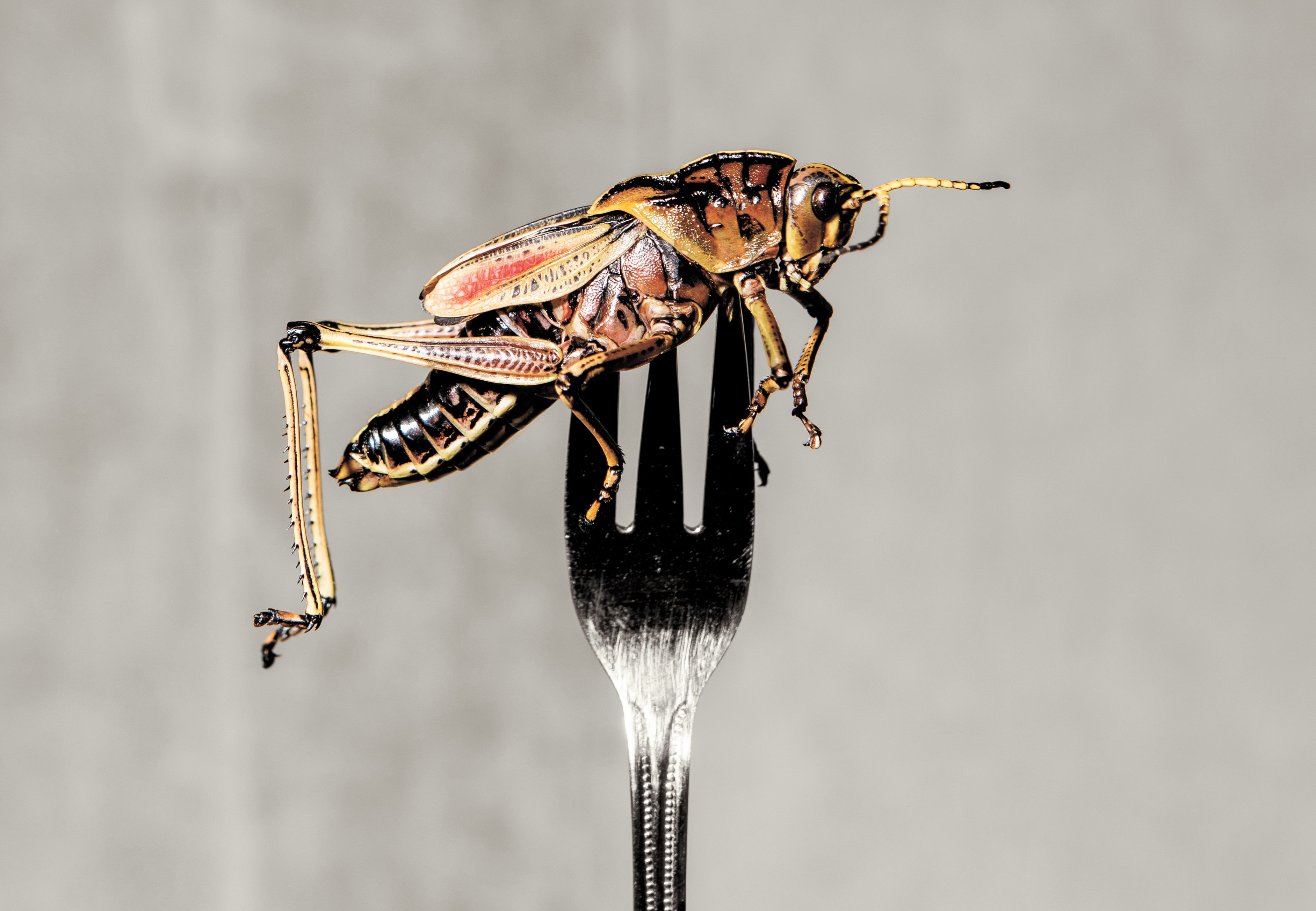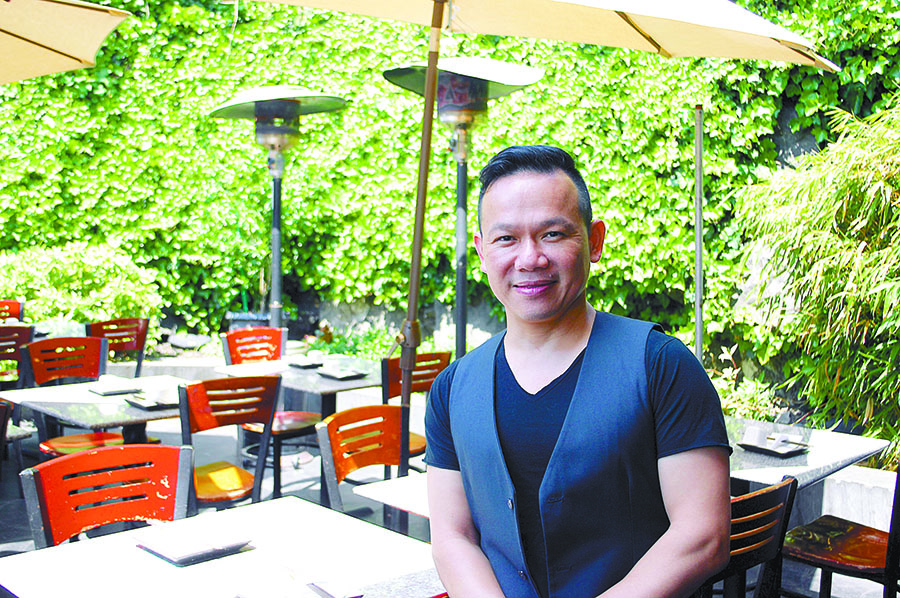Meeru Dhalwala will forever remember the orange roughy dish she prepared years ago. Never could she have suspected that serving this over-fished deep-sea perch would one day lead her to crunch into a concoction of crispy crickets and a squirming swirl of live wax worms that she skittishly slid into her mouth. Admittedly, she was repulsed, grossed out—but intrigued. It wasn’t that bad, and no, these cold-blooded critters didn’t taste like chicken. The crickets had an earthy, nutty flavor, Dhalwala remembers, and those worms, why, they reminded her of pistachios. “And to think I was a frilly little girl, scared to death of bugs,” she says, her face crinkling into a playful grin.
On the last day of September, the dining room at Shanik, the sleekly appointed Indian restaurant Dhalwala opened two years ago in South Lake Union, is as dim as the late-afternoon skies outside, where a soft rain has begun to fall.
The dinner rush is hours away and a pleasant lull has taken hold, only the muffled jangle of kitchen pots and pans. Dhalwala is seated at a table, dressed in a black jumper, her hands wrapped around a cup of steamy chai. She’s eager to tell the story of how she came to embrace the creepy-crawly world of eating and serving six-legged creatures—well, at least ground-up crickets, for the time being. It is one of many insects, scientists and nutritionists believe, that could become the protein-rich meat of the future—indeed, the other other white meat. Jiminy Cricket!
“I was the chef and owner with my partner at Vij’s in Vancouver [B.C.],” Dhalwala begins, “and this very prominent food writer came in, and after he saw me with the roughy, he asked, ‘Do you realize that you are serving an endangered fish?’ I thought, ‘Oh my God, I’m serving an endangered fish?’ I was shocked because I had been reading about climate change and had discovered all this information about sustainability. And I believe in serving the right food because it is a responsibility, like bathing your children. My job is to give my customers well-sourced food.”
Dhalwala, who turned 50 earlier this month, is an animated woman with a shiny thicket of curly black hair. Born in India, she was raised by socially conscious parents in the tony northern-Virginia enclaves south of Washington, D.C. She speaks quickly in big thirsty gulps, her hands in perpetual, punctuating motion.
“No, I’d never eat a cockroach,” she says with a pretend shudder. “No, no, no, and never a scorpion or any sort of spider—only insects that are raised for human consumption, like crickets and grasshoppers and mealworms. Besides, my mom said it was bad luck to kill a spider.”
Seldom will a day pass, explains Dhalwala, when she doesn’t sit for a solid hour and read nonfiction, which is how, in the midwinter of 2008, she stumbled upon an article that stole her full attention. It was a story in The New York Times Magazine, cleverly titled “Man Bites Insect,” about a bug-devouring man named Dave Gracer.
A writing teacher at a community college in Providence, R.I., Gracer consumes insects—“I’ve eaten at least 5,000 insects at this point, and probably 60 to 70 different species of them,” he told me earlier this month—not only because he truly likes them, whether sauteed, filleted, or roasted, but because, he says, they are nutritious and easy to raise without harming the environment.
The line in the article that most moved Dhalwala was Gracer’s quote: “Insects can feed the world. Cows and pigs are the S.U.V.’s; bugs are the bicycles.” To this day, she enjoys reciting the passage.
Enraptured by the notion that insects, already eaten by a majority of the world’s inhabitants, could solve the problem of food sustainability—and might someday land as the plat du jour at her restaurant—Dhalwala tracked down Gracer. She told him she was interested in learning about the potential of bug farming and perhaps adding insect dishes to Vij’s seasonal bill of fare. She asked if he would come to Vancouver. Gracer said he couldn’t—but really there was no reason to, for living just down the road in Seattle was none other than David George Gordon, a renowned entomophagy (bug-eating) expert and a personal friend of Gracer.
Give him a call, Gracer advised, and tell the Bug Chef, as he’s known far and wide, that Gracer sent him. Dhalwala did just that, and Gordon—the Lake City–based author of The Eat-a-Bug Cookbook (first published in 1998) who’s sometimes referred to as the “Godfather of Insect Cuisine”—was only too happy to oblige. Gordon was flattered when she reached out to him, almost as much as he’d been some years before when The New York Times heralded his Field Guide to the Slug as “gripping.” Gordon knew of her Vancouver eatery, known for its imaginative creations and wild-harvested ingredients and hailed by food writers as among the finest Indian restaurants in the world.
Within a week, Gordon was on his way north in his ’93 Toyota Tercel for a taste-testing with Meeru, her husband Vikram, and assorted members of the restaurant staff. He brought samples of dried European house crickets, Mexican chapulines (small grasshoppers), king mealworms in Ziploc bags, and live wax worms slithering about in a plastic carton.
“I ate the crickets, but I really didn’t want the worms,” recounts Dhalwala. “But David put them right there in front of my face, like it was nothing to him, which it isn’t. So I grabbed them and popped them in my mouth like it was a grape. I felt really bizarre inside me. But I was trying to be professional.”
Dhalwala found a cricket supplier, Reeves Cricket Ranch, up in Everson, Wash., near Bellingham. “I called him and asked him, ‘Are your crickets good for human consumption?’ And he goes, ‘Ugh.’ Then he laughed and said, ‘Yes, I can do it.’”
For many years, like most cricket farmers, Clyde Reeves has been selling his critters to places like the San Diego Zoo and big pet-food suppliers. ($15 fetches a thousand Reeves crickets.) “People like to feed them to their lizards, bearded dragons, mice, and the like,” says Reeves. More recently, Reeves has been looking to market some of the 2.5 million crickets, raised on apple feed and hatched weekly at his 10,000-square-foot plant, for human consumption. “We’ve done a lot of testing, and we are getting close to coming up with cricket flour that can be ground into burgers or into pancake and cookie dough.” His daughter, Courtney, will soon be opening a facility in Phoenix, charged with turning the insects into snacks—Jurassic Snacks.
Cricket Parantha from Shanik. Photo by Kyu Han
Not long after Meeru and Vikram devised a recipe for what they eventually named cricket parantha—an appetizer of crickets seasoned with Indian spices and mashed into flatbread—a veritable food fight erupted. “I got hate mail when I first started serving them [in Canada],” exclaims Dhalwala. “A lot of people were very upset. I got e-mails like, ‘You are an embarrassment to the Indian culture’ and ‘First crickets, what’s next, mud from Haiti?’ People were much more accepting in Seattle.”
On May 13, 2013, the Food and Agriculture Organization of the United Nations issued a seminal report that raised deep concerns about global food security. The stunning document, titled “Edible Insects,” strongly suggests that eating insects might be the effective way to fight world hunger, and reminds Westerners to get over their bug phobias and join the other two billion people on the planet, mostly in Asia, Africa, and Latin America, who have long supplemented their diets with slimy, cringe-inducing creatures.
By 2050 the world’s population will exceed 9.2 billion, and the demand for meat and fish will grow with it. The U.N. predicts that 70 percent more food will be needed to sustain that population.
In the report, the authors offer this somber assessment: “To accommodate this number, current food production will need to almost double. Land is scarce and expanding the areas devoted to farming is rarely a viable or sustainable option. Oceans are over-fished and climate change and related water shortages could have profound implications for food production. To meet the food and nutrition challenges of today—there are nearly 1 billion chronically hungry people worldwide—and tomorrow, what we eat and how we produce it needs to be re-evaluated. Inefficiencies need to be rectified and good wastes reduced. We need to find new ways of growing food.”
Water Bugs from Crunchy Critters, courtesy of David George Gordon. Photo by Nate Watters
Enter insects, of which there are six million species on Earth, 1,900 of them edible. Beetles, wasps, caterpillars, dragonfly larvae, water bugs, ants, locusts, and grasshoppers, to name only a few, are high in protein, micronutrients such as iron and zinc, and mineral content. Crickets, in particular, used widely in the South a half-century ago as fish bait, were highlighted in the groundbreaking U.N. report as an invaluable food source. And they need 1/12 the feed that cattle do to produce an equivalent amount of protein.
From an ecological standpoint, eating insects would seem a no-brainer. Raising and harvesting them requires nowhere near as much land, water, and energy consumption as it takes to bring cows, pigs, and sheep to your dinner table—not to mention that insects, unlike farting cows, emit virtually no greenhouse gases. Agriculture accounts for 8.1 percent of the greenhouse gases in the United States.
“There were one million downloads of this report in the first 24 hours after it came out,” marvels Dr. Florence Dunkel, a well-regarded entomologist at Montana State University and editor of The Food Insect Newsletter. Her husband calls her Ladybug. “For the very first time, experts throughout the world,” Dunkel contributed to the “Edible Insects” report, “all had the same message: that this is the food of the future.”
“Outside of some apocalyptic event, insect-eating, especially crickets and cricket flour, is definitely here to stay,” says Dr. Aaron Dossey. Two years ago, the Bill and Melinda Gates Foundation awarded Dossey’s company, “All Things Bugs,” a grant to pursue its project of coming up with a viable insect protein to combat malnutrition in children.
Oddly enough, though many of us may wince at the notion of sitting down to a plate of curried termite stew or a creamy katydid soup, we are already eating bugs. For years the FDA has put out a handbook on “defect labels,” spelling out what potential contaminants are acceptable in processed, canned, or frozen foods. Peanut butter, for one, is allowed 30 insect fragments per 100 grams (thus there are possibly as many as 135 fragments in a 16-ounce jar), and chocolate passes muster at up to 60. And let us not forget that honey is bee vomit.
Man and bugs have been grazing on each other since the beginning of time. Usually the bug has gotten the worst of it. The Greeks snacked on them. Beetle larvae were like caviar to ancient Romans. The Old Testament makes frequent mention of feasting on crickets and grasshoppers. An influential article on insect-eating in The New Yorker several years ago reported, “The manna eaten by Moses on his way out of Egypt is widely believed to have been honey dew, the sweet excrement of scale insects.” And Gordon notes in his Eat-A-Bug Cookbook that the first peoples of North America were avid bug eaters.
Hollywood has long portrayed the eating of bugs as disturbing and disgusting; in the recent movie Snowpiercer, the huddled masses at the back of the train speeding through a post-apocalytic cold world are fed black protein bars composed of the bodies of insects. Yet go to a movie house today in Colombia and don’t be surprised to see patrons munching on big-butt ants, brown cockroach-sized guys, like they were popcorn.
Listen to Gordon the Bug Chef describe the taste of the many edible arthropods he’s put down the old gullet in his many years involved in entomological epicureanism. “Yeah, I like the tails and claws of scorpions,” he muses. “The legs of tarantulas are great, a lot of muscle and very chewy. I do them deep-fried and they taste like crab.” He goes on. “Tomato horn worms are good too, nice and meaty. They have a leafy green taste. I make little hot dogs with them. Now grasshoppers, those little chapulines from Mexico, I season them with chili sauce and lime. Wax worms are actually white caterpillars. They have a sweet taste when cooked, kind of like pistachio nuts.”
Gordon is a trip. At the drop of a batch of sweet-and-sour silkworms—one of the 40 recipes in his award-winning cookbook—he will embark on still another culinary road less traveled. He’s a sweet, kindly man with a wizardly air and the bespectacled persona of an absent-minded professor. He comes with a spray of grayish-white hair, a scruffy goatee, a slight paunch, and a mischievous gleam in his eyes that declares I know you may think this odd, but I really can whip up a mean scorpion scaloppine.
To the burgeoning clan of insect-eating devotees, Gordon is a cult hero—in the same exalted class as Dave Gracer. Excited, Gracer informs me in a phone call that he went on a 75 percent insect diet in 2008 and lost 14 pounds, and that when it was over 30 days later, he felt better than Tony the Tiger. That year, Gracer appeared on The Colbert Report. He brought a platter of bugs, and before a crowd “Eew!”ing loudly, gobbled down a palm-sized dry-toasted cicada as if it were a slice of blueberry pie. The high-voltage Gracer boasts that it was he who arranged the choreography (bugs and all) for the insect-eating party where Mark Ruffalo meets Gywneth Paltrow in the 2012 comedy-drama Thanks for Sharing.
Gordon, 64, lives in a modest two-story home tucked away in a shadowy glen in Lake City, just around the corner from the Bigfoot Car Wash. “I think that’s fitting,” he cracks, “since I’m working on another book on Sasquatch.” The walls of the top floor are lined with moody landscapes, painted by his wife Karen Luke Fields, who did the illustrations for the bug cookbook. In his tiny crammed office, bookshelves filled with a stewpot of natural-history tomes climb to the ceiling. In one bookcase are giant water beetles encased in glass, dozens of live mealworms, a flying cockroach (long deceased), and a mounted pair of scorpions clinking miniature martini glasses.
In his garage sits a large white freezer. It is where Gordon keeps the bug food he needs when traveling the country to share his exotic cuisine in presentations at colleges, science fairs, and various entomological workshops. For the road, he packs a deep-fat fryer in his suitcase; frozen bugs are placed in an insulated beer cooler with blue ice and checked as baggage. He’s taken his show—which he’s given such teasing titles as “From Soup to Gnats: Adventures in Bug-Eating” and “Adventures in Entomophagy: Waiter, There’s NO Fly in My Soup”—to the Smithsonian, the San Francisco Botanical Garden, and, naturally, Ripley’s Believe It or Not! museums in Hollywood and Times Square. On this early October day, his freezer brims with plastic pouches containing centipedes, scorpions, tarantulas, crickets from Cambodia, and grasshoppers from Florida.
“I have probably served more bugs to people than anyone in the world—I’d say 50,000 bugs [served] since I started doing this 16 years ago,” says Gordon. His usual presentation: “I’ll start out with mealworms dipped in tempura batter. They look like Cheetos. Then it is on to the cricket stir-fry, and then the breaded scorpion scaloppine and grasshopper kebabs. The grand finale is the deep-fried tarantula.”
The Bug Chef grew up on the north side of Chicago. When he was 5, Gordon’s father, a production foreman at Helene Curtis Cosmetics, bought him an aquarium. “I was mesmerized by it. I’ve been a nature nut all my life. Some people are born with their passions; I know I was. I spent most of my time as a kid in our little backyard, crawling around, looking for ants. Marlin Perkins was my hero.” And so was his mother, a high-school English teacher. His dad died when he was young, and it was Mom who raised the family. Gordon dedicated one of his books to her, The Compleat Cockroach. Why? “Because she always said you can always find something nice to say about anyone.” After a pause, he adds, “Did you know there are 3,500 different kinds of cockroaches? It comes from the Spanish word, la cucaracha.”
With a degree from Northwestern University in aquatic biology, Gordon headed west in 1981 to take a job setting up exhibits at the Point Defiance Zoo & Aquarium in Tacoma. “I was blown away by Elliott Bay, and pretty soon I started writing my Field Guide to the Gray Whale. But it was the Field Guide to the Slug that came out in 1994 that was a changing moment. I found that if you can get people excited about writing about slugs, anything was possible.”
These days, Gordon continues, “bugs are becoming a very trendy good. I travel around Middle America and people are still grossed out, but among the young foodies out here, they are titillated.”
While the thought of biting into an insect may trigger your gag reflex, so it was for many Americans in the post-World War II years when Chinese cuisine, just beginning to take root in suburban areas, seemed strange and mysterious. Similar reactions greeted the arrival of sushi.
As Tulio chef and owner Walter Pisano puts it, “Remember when tongue was first put on the menu? I mean, tongue?! And then there was bone marrow and so on. I think this is all going to be very interesting. The public will decide if eating insects is a trend.” As for now, Pisano is sticking to Italian fare at his downtown establishment.
Crickets for Cricket Paranta from Shanik. Photo by Kyu Han
“We’ve got to get over our silly fears,” observes Thierry Rautureau, owner of the Loulay, a French bistro downtown near the Sheraton Hotel. “I’ve had crickets and they are delicious, but it’s going to take a while to get people on board. But I think they will.” He too has no plans to put an insect dish on the menu.
In fact fewer than 20 restaurants nationwide, most of them high-end eateries, have bravely ventured into offering bugs. In Seattle, in addition to Shanik, there’s Poquitos on Capitol Hill, where one can get a small plate of roasted grasshoppers for $2. (La Carta de Oaxaca in Ballard also serves crickets, though they are not listed on the menu.)
Gordon, a vegetarian during his salad days, gobbled down his first bug in 1996, not long after his cockroach book was published. It was at a bug fair in Everett. The critter, he recalls, was a small, dark-gray cricket lying dry-frozen in a bowl of Chex Mix. “Since then, I eat bugs once a week, mainly because I am working on recipes for them,” he says.
“My first wife didn’t appreciate what I was doing. We used to get into some pretty ugly fights over what I was doing for a living,” ruminates Gordon. “My daughter was 10 when I wrote the cookbook [in 1998]. She thought it was wrong, gross. But then the years went by, and so one day she heard about this radio promotion on The End [107.7 FM] that they were doing. If you could do something really weird, then the winner, they said, would get to meet Radiohead. Well, she really wanted to meet Radiohead, and told them she would eat insects. And she got on the air and ate a centipede and a grasshopper. She won!”
“I can’t keep crickets in stock,” says Justin Marx, who in November 2012 opened a specialty foods store on Lower Queen Anne. “My first order six months ago, we sold 10 cartons [each containing 150 crickets]. Now I’m hitting 30 cartons. I’m blown away.”
Marx Foods is a culinary concierge. This is where one ventures for niche products such as Peeks Pantry bun jam, pine-cone-bud syrup, maybe some fennel pollen or green-cucumber vinegar, or perhaps a $30 jar of Fiddyment Farms pistachio paste. The colatura (Roman fish sauce) is to die for, enthuses Marx. He also sells kangaroo meat for $11 a pound. “Rich people come in to buy it for their dogs.”
As for the uptick on crickets, “I’m not surprised. It’s going to be a future protein, as soon as we get over the psychological barriers. I eat it myself,” says Marx. “It’s not really the flavor they come for [in cricket], because there’s really not too much to it. It’s driven, I think, by an environmental consciousness.”
Every few months Marx and his staff assemble in the test kitchen around the corner from the small showroom, break out the booze and wine, and try the latest foodstuffs that come their way. “We tested some insects recently. I think we went through 20 species. We rejected the giant male rhino beetle. Too tough.”
Since late July, Central Co-op has been selling packets of mealworms, roasted crickets, and cricket flour, which runs a pricey $77 a pound. The mealworms, says marketing director Susanna Schultz, make a good salad topping. As for the crickets, “I’ve been to dinner parties where people have brought them out as conversation pieces,” she says.
I must inquire: What do vegetarians say about this?
“Well,” slowly replies Schultz, “we have had a small number of vegans who thought this was a step too far.”
Pat Crowley, founder of Chapul, a Salt Lake City–based company which each month sells some 15,000 cricket energy bars to health-food stores and places like Central Co-op, tells me, “I think we’re going to be seeing crickets in our breakfast cereal, in veggie burgers, pizza, and pasta. It’s just a superior form of protein.”
But all the fuss crickets are getting really bugs Gordon. “There are 1,900 other species to choose from, so why are we eating the same thing you get in a pet feed store? I know that crickets and mealworms are the only insects being raised commercially, but we need to move on,” he says. “I think the next big thing will be locusts and grasshoppers.”
Like Gordon, Dunkel, the 72-year-old Montana State entomologist, looks forward to a more adventurous insect diet—something besides crickets to chirp about. She too is a bug chef of sorts. “You know, my husband hunts deer; I hunt grasshoppers. I harvest from my own garden here in Bozeman. I do sauteed grasshopper in soy sauce and put it over fresh spinach,” says Dunkel.
“Black ants are also quite delicious,” Dunkel happily continues. “I’ve had them as decorations on white cake. I’ve also had silkworm pupae and cream cheese. That’s very good. I did in Montreal once have an opportunity to eat scorpion, but I passed on it. Never had a cockroach, either, but I hear they’re very good.”
At last it’s time for me to eat cricket. Meeru Dhalwala wouldn’t have it any other way. In the kitchen she spreads several hundred frozen crickets onto a steel container. “Now I’m going to add a little bit of olive oil and sprinkle them with salt. You see? Then I add the red chili pepper and gently mix it all together. I know, it grosses people out, because yes, they still look like they are alive.” She puts them into the oven, where they will roast for three minutes at 375 degrees.
Dhalwala cuts up cilantro, jalapenos, cumin seeds (“I like a lot of cumin”), and ginger. It will all be blended into a bran- and whole-wheat-flour dough, softened with buttermilk.
“You find crickets in the bush, and so the cilantro is like the leaves in the bush,” she says. “The ginger is like the brush, and the jalapeno is the grass, and the cumin, the cumin is the dirt. I worked at least a month on this recipe before we started serving it earlier this year. This is not something you’d find in a cookbook.”
The dough is rolled flat and placed into a sizzling-hot iron pan. It is nearly done, a small pizza that will be topped with tomato-onion chutney and a small tangle of cabbage and kale. “The key is to make it palatable, non-threatening. To do that, you need to hide the crickets. The chutney acts as the pizza sauce.” Dhalwala says she serves as many as 10 orders of cricket parantha on a busy Saturday night.
“Are you ready for a piece?” I take it in my hands, and for all the world it looks like a slice of pizza. I bite into it. Good, very good. I can taste the spices, the heat from the jalapenos, the fresh smell of cilantro and ginger. And then comes the unmistakable crunch, crunch, crunch. I cannot pretend that it is something other than pulverized cricket littered within that dough, for I saw these varmints only minutes before lying ugly and naked on that steel container.
Later a colleague asks, “What did the crickets taste like?”
“Earthy, I guess, nutty,” I say, “but overall, sort of tasteless, really. They’re just crunchy.”
Still, something tells me this whole matter of eating bugs will not fade away anytime soon. It’s a movement that has legs. The Bug Chef, David George Gordon, will appear at Marx Foods (144 Western Ave. W., 447-1818) on Thursday, October 30 from 5 to 7 p.m. to present a range of edible insects and explore how they pair with various flavors. The event is open to the public.
econklin@seattleweekly.com








